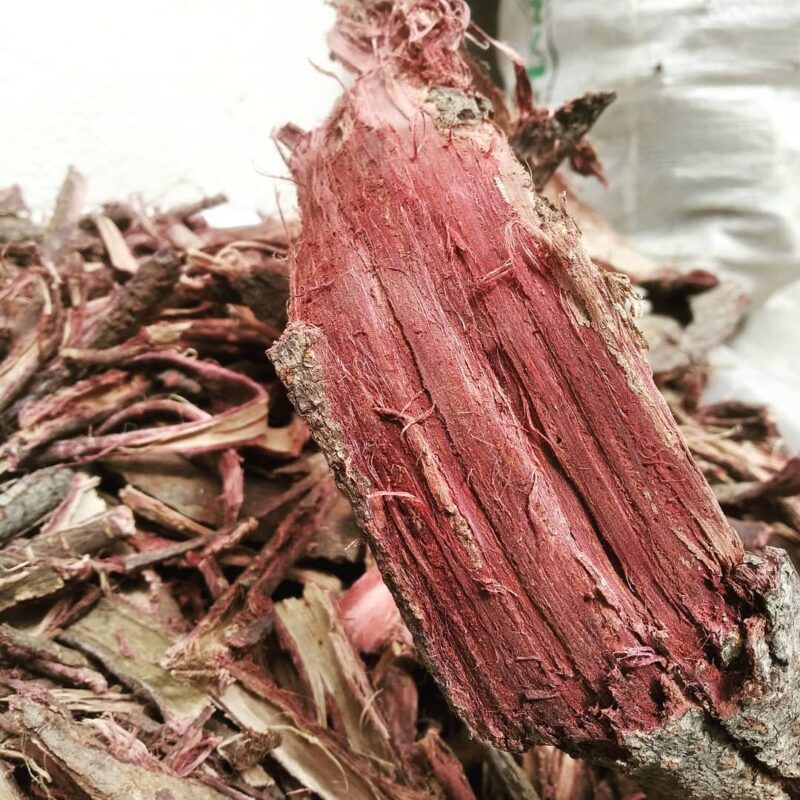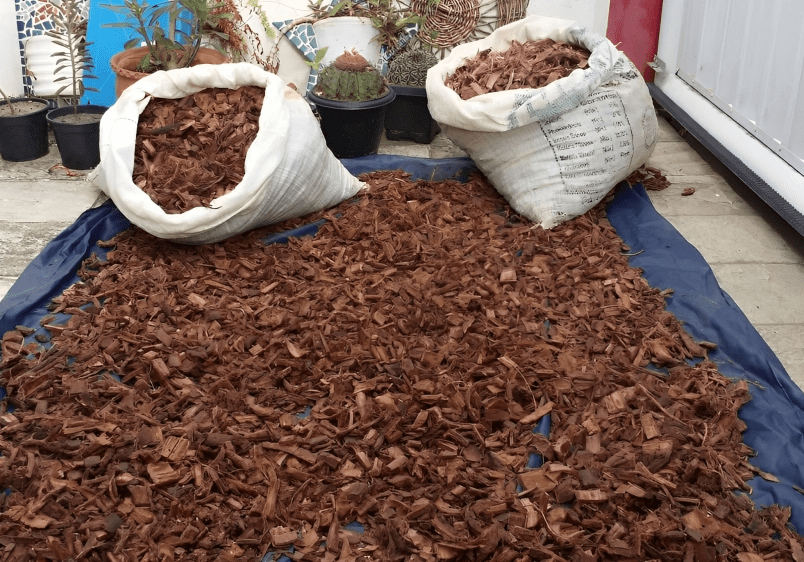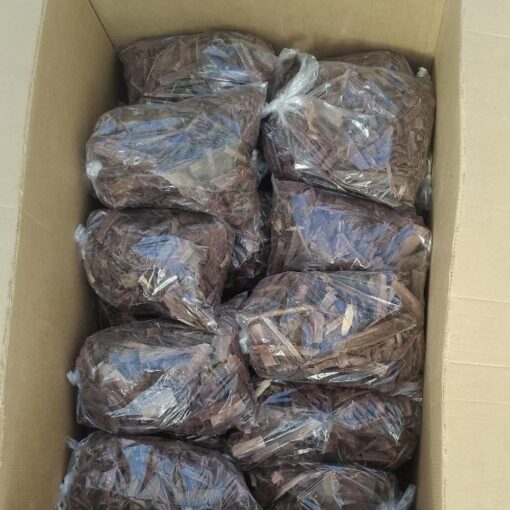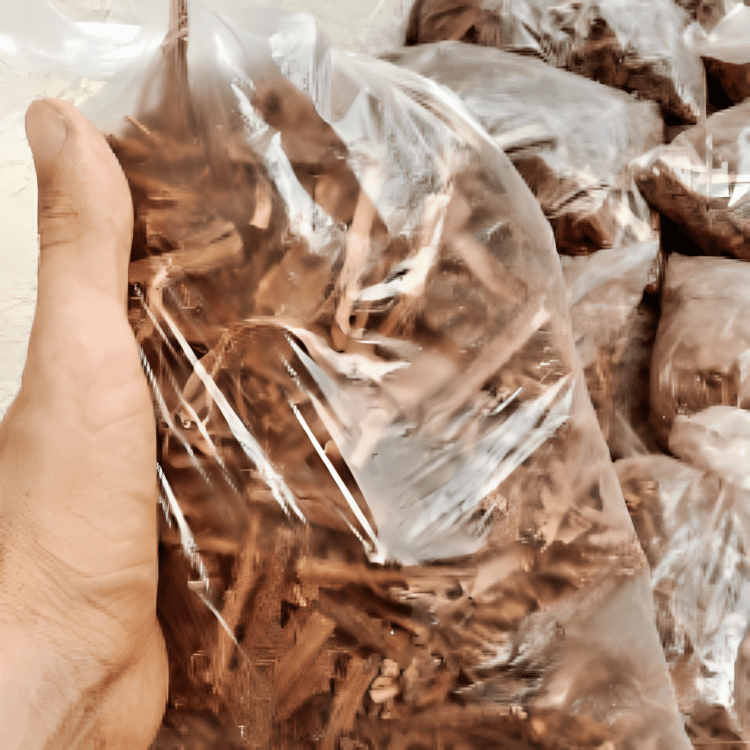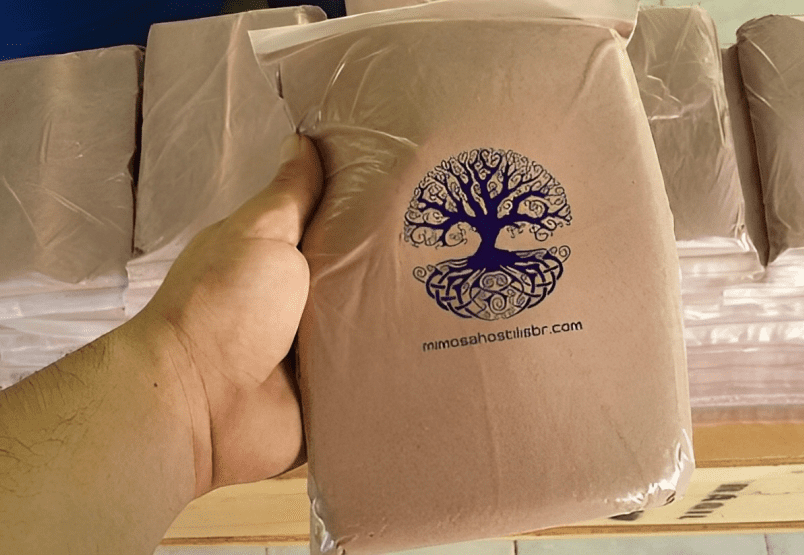Organic Root Dye From Brazil.
Brazilian Mimosa Hostilis root bark
About our Brazilian Mimosa hostilis inner root bark
The home of our Mimosa hostilis bark is Bahia in the Northeast Region of Brazil, where it is growing in its natural habitat. The region is widely recognized for its history and culture, but also its beautiful natural sights and hot weather. A hot dry winter and a cold rainy summer make a perfect combination for our Mimosas. People in Brazil call it “Jurema” or “Jurema Preta”.
We think you are wondering how the bark is harvested and processed. Answering right away the most frequent question: No, harvesting is not harmful for Mimosa trees and its population. Our suppliers are people of those places. They are very caring, farmers who love and feel nature in every expression. We agreed with them on the purpose of making the world a kinder place.
Our suppliers of Mimosa Root Bark carefully select only the adult trees for harvesting. The knowledge and experience help them to take the exact amount from a tree without harming it, which also influences the quality of the final product.
After the best root bark is picked, it goes drying, of course, the same day. Active ingredients are preserved by processing Mimosa indoors to avoid the devastating effect of the sun’s UV rays as well as extra moisture in a product. Further, already dried Jurema is divided into parts: one goes for processing into powder, the other for shredded finish.
Is it powdered or Shredded? Another frequently asked question we receive is about the difference in purpose, weight, and price between powdered and shredded Mimosa Hostilis Root Bark.
First of all, the form of Mimosa to work with is a personal preference. It is your right to choose, to look, and to try that is why we are offering both.
Our production has a special bark mill, which helps to process mimosa in the best way. The fibbers which are lighter of color are carefully sieved out, as a result, the end product has a darker color, which indicates its purity and highest level of filtration.
Showing all 5 resultsSorted by latest
-
$1700 – $11000
Mexican – Mimosa hostilis Inner Root Bark (MHRB) – Whole
Rated 4.57 out of 5Buy now This product has multiple variants. The options may be chosen on the product pageClear50g100g350g800g -
$1600 – $21000
Mexican – Mimosa hostilis Inner Root Bark (MHRB) – shredded
Rated 4.86 out of 5Buy now This product has multiple variants. The options may be chosen on the product pageClear50g100g350800g1kg -
$1645 – $110001kg mimosa hostilis, bark pouch, barkwiki, best mimosa hostilis root bark, best place to buy mhrb, best place to buy mimosa hostilis, best place to buy mimosa hostlis, brazilian mhrb, brazilian mimosa, brazilian mimosa hostilis, brazilian mimosa hostilis root bark, buy dmt bark, buy mhrb, buy mhrb powder, buy mhrb usa, buy mimosa bark, buy mimosa hostilis, buy mimosa hostilis bark, buy mimosa hostilis powder, buy mimosa hostilis root bark, buy mimosa hostilis root bark europe, buy mimosa hostilis root bark powder, buy mimosa hostilis root bark usa, buy mimosa hostilis uk, buy mimosa hostillis, buy mimosa tree, buying mimosa hostilis, buying mimosa hostilis root bark, cheapest mimosa hostilis root bark, chopped mimosa hostilis, chopped mimosa hostilis root bark, comprar mimosa hostilis, ebay mimosa hostilis, ground mimosa hostilis root bark, high quality mimosa hostilis root bark, hostilis mimosa root bark, hostilis mimosa root bark powder, how to harvest mimosa bark, how to harvest root bark, how to make dye from mimosa hostilis root bark, is mhrb legal, is mimosa hostilis root bark legal, jurema mimosa hostilis root bark, jurema root bark, mexican mimosa hostilis root bark, mhrb, mhrb bark, mhrb buy, mhrb chopped, mhrb dye, mhrb dye powder, mhrb ebay, mhrb for sale, mhrb for sale near me, mhrb near me mimosa hostilis price, mhrb poeder, mhrb powder, mhrb powder amazon, mhrb powder dye, mhrb powder for sale, mhrb powder for sale usa, mhrb powder uk, mhrb powder usa, mhrb powdered, mhrb shop, mhrb shredded, mhrb soap, mhrb tea, mhrb uk, mhrb usa, mhrb usa vendor, mimosa bark, mimosa bark for sale, mimosa bark powder, mimosa bark store, mimosa hostilis, mimosa hostilis 1kg, mimosa hostilis australia, mimosa hostilis bark, mimosa hostilis bark amazon, mimosa hostilis bark for sale, mimosa hostilis bark powder, mimosa hostilis bark powder usa, mimosa hostilis bark uk, mimosa hostilis bestellen, mimosa hostilis buy, mimosa hostilis buy online, mimosa hostilis dye, mimosa hostilis ebay, mimosa hostilis europe, mimosa hostilis for sale, mimosa hostilis for sale usa, mimosa hostilis inner root bark, mimosa hostilis inner root bark powder, mimosa hostilis inner root bark uk, mimosa hostilis kaufen, mimosa hostilis kaufen 1kg, mimosa hostilis kopen, mimosa hostilis legality, mimosa hostilis mexico, mimosa hostilis near me, mimosa hostilis online, mimosa hostilis plant for sale, mimosa hostilis powder, mimosa hostilis powder amazon, mimosa hostilis powder uk, mimosa hostilis powder usa, mimosa hostilis powdered, mimosa hostilis romania, mimosa hostilis root bark, mimosa hostilis root bark 1000g, mimosa hostilis root bark 1kg, mimosa hostilis root bark 500g, mimosa hostilis root bark alibaba, mimosa hostilis root bark amazon, mimosa hostilis root bark amazon uk, mimosa hostilis root bark australia, mimosa hostilis root bark brazil, mimosa hostilis root bark bulk usa, mimosa hostilis root bark buy, mimosa hostilis root bark california, mimosa hostilis root bark cheap, mimosa hostilis root bark chips, mimosa hostilis root bark company, mimosa hostilis root bark dye, mimosa hostilis root bark ebay, mimosa hostilis root bark etsy, mimosa hostilis root bark europe, mimosa hostilis root bark for sale, mimosa hostilis root bark for sale near me, mimosa hostilis root bark for sale south africa, mimosa hostilis root bark for sale uk, mimosa hostilis root bark for sale usa, mimosa hostilis root bark greece, mimosa hostilis root bark harvest, mimosa hostilis root bark in arabic, mimosa hostilis root bark ireland, mimosa hostilis root bark kaufen, mimosa hostilis root bark kopen, mimosa hostilis root bark legal, mimosa hostilis root bark legality, mimosa hostilis root bark malaysia, mimosa hostilis root bark mexico, mimosa hostilis root bark near me, mimosa hostilis root bark online, mimosa hostilis root bark poland, mimosa hostilis root bark powder, mimosa hostilis root bark powder 100g, mimosa hostilis root bark powder 1kg, mimosa hostilis root bark powder 1kg amazon, mimosa hostilis root bark powder amazon, mimosa hostilis root bark powder bulk, mimosa hostilis root bark powder buy, mimosa hostilis root bark powder cheap, mimosa hostilis root bark powder dye, mimosa hostilis root bark powder dye australia, mimosa hostilis root bark powder ebay, mimosa hostilis root bark powder europe, mimosa hostilis root bark powder for sale, mimosa hostilis root bark powder for sale usa, mimosa hostilis root bark powder india, mimosa hostilis root bark powder near me, mimosa hostilis root bark powder uk, mimosa hostilis root bark powder usa, mimosa hostilis root bark powder usa vendor, mimosa hostilis root bark powder wholesale, mimosa hostilis root bark powdered, mimosa hostilis root bark romania, mimosa hostilis root bark sale, mimosa hostilis root bark seeds, mimosa hostilis root bark ships from usa, mimosa hostilis root bark shredded, mimosa hostilis root bark soap, mimosa hostilis root bark south africa, mimosa hostilis root bark spain, mimosa hostilis root bark uk, mimosa hostilis root bark uk ebay, mimosa hostilis root bark uk for sale, mimosa hostilis root bark us, mimosa hostilis root bark usa, mimosa hostilis root bark usa vendor, mimosa hostilis root bark wholesale, mimosa hostilis root bark wiki, mimosa hostilis root for sale, mimosa hostilis root powder, mimosa hostilis rootbark, mimosa hostilis sale, mimosa hostilis seeds amazon, mimosa hostilis seeds uk, mimosa hostilis shop, mimosa hostilis south africa, mimosa hostilis tree bark, mimosa hostilis tree for sale, mimosa hostilis uk, mimosa hostilis usa, mimosa hostillis bark, mimosa hostillis root bark powder, mimosa hostillis rootbark, mimosa powdered, mimosa root bark, mimosa root bark amazon, mimosa root bark dye, mimosa root bark for sale, mimosa root bark near me, mimosa root bark powder, mimosa root bark powder uk, mimosa root bark uk, mimosa root bark usa, mimosa root bark vendor, mimosa root powder, mimosa root shop, mimosa root shop reviews, mimosa tenuiflora bark extract, mimosa tenuiflora for sale, mimosa tenuiflora root bark, mimosa tenuiflora tree, mimosa tree bark for sale, mimosa tree root bark, mimosas hostilis, my mhrb shop, powdered mhrb, powdered mimosa, powdered mimosa hostilis, powdered mimosa hostilis root bark, root bark, root bark mimosa hostilis, root bark powder, shop for mimosa root bark, shredded mimosa hostilis, shredded mimosa hostilis root bark, usa mhrb, what is mhrb, where to buy mhrb, where to buy mimosa hostilis, where to buy mimosa hostilis bark, where to buy mimosa hostilis root bark, where to buy mimosa hostilis root bark powder, where to get mimosa hostilis root bark
Mimosa hostilis Inner Root Bark (MHRB) – Whole
Buy now This product has multiple variants. The options may be chosen on the product pageClear50g100g350g800g -
$1600 – $210001kg mimosa hostilis, 1kg mimosa hostilis root bark dye dmt, bark pouch, barkwiki, best mimosa hostilis root bark, best place to buy mhrb, best place to buy mimosa hostilis, best place to buy mimosa hostlis, brazilian mhrb, brazilian mimosa, brazilian mimosa hostilis, brazilian mimosa hostilis root bark, buy dmt bark, buy mhrb, buy mhrb usa, buy mimosa bark, buy mimosa hostilis, buy mimosa hostilis bark, buy mimosa hostilis powder, buy mimosa hostilis root bark, buy mimosa hostilis root bark europe, buy mimosa hostilis root bark powder, buy mimosa hostilis root bark usa, buy mimosa hostilis seeds, buy mimosa hostilis uk, buy mimosa hostillis, buy mimosa tree, buying mimosa hostilis, buying mimosa hostilis root bark, cheapest mimosa hostilis root bark, chopped mimosa hostilis, chopped mimosa hostilis root bark, comprar mimosa hostilis, dmt root for sale, ebay mimosa hostilis, ground mimosa hostilis root bark, high quality mimosa hostilis root bark, hostilis mimosa root bark, hostilis mimosa root bark powder, how to harvest mimosa bark, how to harvest mimosa hostilis root bark, how to harvest root bark, how to make dye from mimosa hostilis root bark, is mhrb legal, is mimosa hostilis root bark legal, jurema mimosa hostilis root bark, jurema root bark, mexican mimosa hostilis root bark, mhrb, mhrb bark, mhrb buy, mhrb chopped, mhrb dye, mhrb dye powder, mhrb ebay, mhrb for sale, mhrb for sale near me, mhrb near me mimosa hostilis price, mhrb poeder, mhrb powder, mhrb powder amazon, mhrb powder dye, mhrb powder for sale, mhrb powder for sale usa, mhrb powder uk, mhrb powder usa, mhrb powdered, mhrb shop, mhrb shredded, mhrb soap, mhrb tea, mhrb uk, mhrb usa, mhrb usa vendor, mimosa bark, mimosa bark for sale, mimosa bark powder, mimosa bark store, mimosa extraction, mimosa hostilis, mimosa hostilis 1kg, mimosa hostilis australia, mimosa hostilis bark, mimosa hostilis bark amazon, mimosa hostilis bark for sale, mimosa hostilis bark powder, mimosa hostilis bark powder for sale, mimosa hostilis bark powder usa, mimosa hostilis bark uk, mimosa hostilis bestellen, mimosa hostilis buy, mimosa hostilis buy online, mimosa hostilis dye, mimosa hostilis ebay, mimosa hostilis europe, mimosa hostilis for sale, mimosa hostilis for sale usa, mimosa hostilis inner root bark, mimosa hostilis inner root bark powder, mimosa hostilis inner root bark uk, mimosa hostilis inner root bark usa, mimosa hostilis kaufen, mimosa hostilis kaufen 1kg, mimosa hostilis kopen, mimosa hostilis legality, mimosa hostilis mexico, mimosa hostilis near me, mimosa hostilis online, mimosa hostilis plant for sale, mimosa hostilis plant seeds, mimosa hostilis powder, mimosa hostilis powder amazon, mimosa hostilis powder for sale, mimosa hostilis powder uk, mimosa hostilis powder usa, mimosa hostilis powdered, mimosa hostilis romania, mimosa hostilis root bark, mimosa hostilis root bark 1000g, mimosa hostilis root bark 1kg, mimosa hostilis root bark 500g, mimosa hostilis root bark alibaba, mimosa hostilis root bark amazon, mimosa hostilis root bark amazon uk, mimosa hostilis root bark australia, mimosa hostilis root bark brazil, mimosa hostilis root bark bulk usa, mimosa hostilis root bark buy, mimosa hostilis root bark california, mimosa hostilis root bark cheap, mimosa hostilis root bark chips, mimosa hostilis root bark company, mimosa hostilis root bark dye, mimosa hostilis root bark ebay, mimosa hostilis root bark etsy, mimosa hostilis root bark europe, mimosa hostilis root bark extract, mimosa hostilis root bark for dye, mimosa hostilis root bark for sale, mimosa hostilis root bark for sale near me, mimosa hostilis root bark for sale south africa, mimosa hostilis root bark for sale uk, mimosa hostilis root bark for sale usa, mimosa hostilis root bark greece, mimosa hostilis root bark harvest, mimosa hostilis root bark in arabic, mimosa hostilis root bark ireland, mimosa hostilis root bark kaufen, mimosa hostilis root bark kopen, mimosa hostilis root bark legal, mimosa hostilis root bark legality, mimosa hostilis root bark malaysia, mimosa hostilis root bark mexico, mimosa hostilis root bark near me, mimosa hostilis root bark online, mimosa hostilis root bark poland, mimosa hostilis root bark powder, mimosa hostilis root bark powder 100g, mimosa hostilis root bark powder 1kg, mimosa hostilis root bark powder 1kg amazon, mimosa hostilis root bark powder amazon, mimosa hostilis root bark powder bulk, mimosa hostilis root bark powder buy, mimosa hostilis root bark powder cheap, mimosa hostilis root bark powder dye, mimosa hostilis root bark powder dye australia, mimosa hostilis root bark powder ebay, mimosa hostilis root bark powder europe, mimosa hostilis root bark powder for sale, mimosa hostilis root bark powder for sale near me, mimosa hostilis root bark powder for sale usa, mimosa hostilis root bark powder india, mimosa hostilis root bark powder near me, mimosa hostilis root bark powder uk, mimosa hostilis root bark powder usa, mimosa hostilis root bark powder usa vendor, mimosa hostilis root bark powder wholesale, mimosa hostilis root bark powdered, mimosa hostilis root bark romania, mimosa hostilis root bark sale, mimosa hostilis root bark seeds, mimosa hostilis root bark ships from usa, mimosa hostilis root bark shredded, mimosa hostilis root bark soap, mimosa hostilis root bark south africa, mimosa hostilis root bark spain, mimosa hostilis root bark uk, mimosa hostilis root bark uk ebay, mimosa hostilis root bark uk for sale, mimosa hostilis root bark us, mimosa hostilis root bark usa, mimosa hostilis root bark usa vendor, mimosa hostilis root bark wholesale, mimosa hostilis root bark wiki, mimosa hostilis root for sale, mimosa hostilis root powder, mimosa hostilis rootbark, mimosa hostilis sale, mimosa hostilis seeds, mimosa hostilis seeds amazon, mimosa hostilis seeds dmt, mimosa hostilis seeds for sale, mimosa hostilis seeds uk, mimosa hostilis shop, mimosa hostilis south africa, mimosa hostilis tree bark, mimosa hostilis tree for sale, mimosa hostilis uk, mimosa hostilis usa, mimosa hostillis bark, mimosa hostillis root bark powder, mimosa hostillis rootbark, mimosa powdered, mimosa root bark, mimosa root bark amazon, mimosa root bark dye, mimosa root bark for sale, mimosa root bark near me, mimosa root bark powder, mimosa root bark powder for sale, mimosa root bark powder uk, mimosa root bark uk, mimosa root bark usa, mimosa root bark vendor, mimosa root powder, mimosa root shop, mimosa root shop reviews, mimosa tenuiflora bark extract, mimosa tenuiflora for sale, mimosa tenuiflora root bark, mimosa tenuiflora tree, mimosa tree bark for sale, mimosa tree root bark, mimosas hostilis, my mhrb shop, powdered mhrb, powdered mimosa, powdered mimosa hostilis, powdered mimosa hostilis root bark, root bark, root bark mimosa hostilis, root bark powder, shop for mimosa root bark, shredded mimosa hostilis, shredded mimosa hostilis root bark, usa mhrb, what is mhrb, where to buy mhrb, where to buy mimosa hostilis, where to buy mimosa hostilis bark, where to buy mimosa hostilis root bark, where to buy mimosa hostilis root bark powder, where to get mimosa hostilis root bark
Mimosa hostilis Inner Root Bark (MHRB) – shredded
Rated 4.83 out of 5Buy now This product has multiple variants. The options may be chosen on the product pageClear50g100g350800g1kg -
$1500 – $230001kg mimosa hostilis, 1kg mimosa hostilis root bark dye dmt, bark pouch, barkwiki, best mimosa hostilis root bark, best place to buy mhrb, best place to buy mimosa hostilis, best place to buy mimosa hostlis, brazilian mhrb, brazilian mimosa, brazilian mimosa hostilis, brazilian mimosa hostilis root bark, buy dmt bark, buy mhrb, buy mhrb usa, buy mimosa bark, buy mimosa hostilis, buy mimosa hostilis bark, buy mimosa hostilis powder, buy mimosa hostilis root bark, buy mimosa hostilis root bark europe, buy mimosa hostilis root bark powder, buy mimosa hostilis root bark usa, buy mimosa hostilis seeds, buy mimosa hostilis uk, buy mimosa hostillis, buy mimosa tree, buying mimosa hostilis, buying mimosa hostilis root bark, cheapest mimosa hostilis root bark, chopped mimosa hostilis, chopped mimosa hostilis root bark, comprar mimosa hostilis, dmt root for sale, ebay mimosa hostilis, ground mimosa hostilis root bark, high quality mimosa hostilis root bark, hostilis mimosa root bark, hostilis mimosa root bark powder, how to harvest mimosa bark, how to harvest mimosa hostilis root bark, how to harvest root bark, how to make dye from mimosa hostilis root bark, is mhrb legal, is mimosa hostilis root bark legal, jurema mimosa hostilis root bark, jurema root bark, mexican mimosa hostilis root bark, mhrb, mhrb bark, mhrb buy, mhrb chopped, mhrb dye, mhrb dye powder, mhrb ebay, mhrb for sale, mhrb for sale near me, mhrb near me mimosa hostilis price, mhrb poeder, mhrb powder, mhrb powder amazon, mhrb powder dye, mhrb powder for sale, mhrb powder for sale usa, mhrb powder uk, mhrb powder usa, mhrb powdered, mhrb shop, mhrb shredded, mhrb soap, mhrb tea, mhrb uk, mhrb usa, mhrb usa vendor, mimosa bark, mimosa bark for sale, mimosa bark powder, mimosa bark store, mimosa extraction, mimosa hostilis, mimosa hostilis 1kg, mimosa hostilis australia, mimosa hostilis bark, mimosa hostilis bark amazon, mimosa hostilis bark for sale, mimosa hostilis bark powder, mimosa hostilis bark powder for sale, mimosa hostilis bark powder usa, mimosa hostilis bark uk, mimosa hostilis bestellen, mimosa hostilis buy, mimosa hostilis buy online, mimosa hostilis dye, mimosa hostilis ebay, mimosa hostilis europe, mimosa hostilis for sale, mimosa hostilis for sale usa, mimosa hostilis inner root bark, mimosa hostilis inner root bark powder, mimosa hostilis inner root bark uk, mimosa hostilis kaufen, mimosa hostilis kaufen 1kg, mimosa hostilis kopen, mimosa hostilis legality, mimosa hostilis mexico, mimosa hostilis near me, mimosa hostilis online, mimosa hostilis plant for sale, mimosa hostilis plant seeds, mimosa hostilis powder, mimosa hostilis powder amazon, mimosa hostilis powder for sale, mimosa hostilis powder uk, mimosa hostilis powder usa, mimosa hostilis powdered, mimosa hostilis romania, mimosa hostilis root bark, mimosa hostilis root bark 1000g, mimosa hostilis root bark 1kg, mimosa hostilis root bark 500g, mimosa hostilis root bark alibaba, mimosa hostilis root bark amazon, mimosa hostilis root bark amazon uk, mimosa hostilis root bark australia, mimosa hostilis root bark brazil, mimosa hostilis root bark bulk usa, mimosa hostilis root bark buy, mimosa hostilis root bark california, mimosa hostilis root bark cheap, mimosa hostilis root bark chips, mimosa hostilis root bark company, mimosa hostilis root bark dye, mimosa hostilis root bark ebay, mimosa hostilis root bark etsy, mimosa hostilis root bark europe, mimosa hostilis root bark extract, mimosa hostilis root bark for dye, mimosa hostilis root bark for sale, mimosa hostilis root bark for sale near me, mimosa hostilis root bark for sale south africa, mimosa hostilis root bark for sale uk, mimosa hostilis root bark for sale usa, mimosa hostilis root bark greece, mimosa hostilis root bark harvest, mimosa hostilis root bark in arabic, mimosa hostilis root bark ireland, mimosa hostilis root bark kaufen, mimosa hostilis root bark kopen, mimosa hostilis root bark legal, mimosa hostilis root bark legality, mimosa hostilis root bark malaysia, mimosa hostilis root bark mexico, mimosa hostilis root bark near me, mimosa hostilis root bark online, mimosa hostilis root bark poland, mimosa hostilis root bark powder, mimosa hostilis root bark powder 100g, mimosa hostilis root bark powder 1kg, mimosa hostilis root bark powder 1kg amazon, mimosa hostilis root bark powder amazon, mimosa hostilis root bark powder bulk, mimosa hostilis root bark powder buy, mimosa hostilis root bark powder cheap, mimosa hostilis root bark powder dye, mimosa hostilis root bark powder dye australia, mimosa hostilis root bark powder ebay, mimosa hostilis root bark powder europe, mimosa hostilis root bark powder for sale, mimosa hostilis root bark powder for sale near me, mimosa hostilis root bark powder for sale usa, mimosa hostilis root bark powder india, mimosa hostilis root bark powder near me, mimosa hostilis root bark powder uk, mimosa hostilis root bark powder usa, mimosa hostilis root bark powder usa vendor, mimosa hostilis root bark powder wholesale, mimosa hostilis root bark powdered, mimosa hostilis root bark romania, mimosa hostilis root bark sale, mimosa hostilis root bark seeds, mimosa hostilis root bark ships from usa, mimosa hostilis root bark shredded, mimosa hostilis root bark soap, mimosa hostilis root bark south africa, mimosa hostilis root bark spain, mimosa hostilis root bark uk, mimosa hostilis root bark uk ebay, mimosa hostilis root bark uk for sale, mimosa hostilis root bark us, mimosa hostilis root bark usa, mimosa hostilis root bark usa vendor, mimosa hostilis root bark wholesale, mimosa hostilis root bark wiki, mimosa hostilis root for sale, mimosa hostilis root powder, mimosa hostilis rootbark, mimosa hostilis sale, mimosa hostilis seeds, mimosa hostilis seeds amazon, mimosa hostilis seeds dmt, mimosa hostilis seeds for sale, mimosa hostilis seeds uk, mimosa hostilis shop, mimosa hostilis south africa, mimosa hostilis tree bark, mimosa hostilis tree for sale, mimosa hostilis uk, mimosa hostilis usa, mimosa hostillis bark, mimosa hostillis root bark powder, mimosa hostillis rootbark, mimosa powdered, mimosa root bark, mimosa root bark amazon, mimosa root bark dye, mimosa root bark for sale, mimosa root bark near me, mimosa root bark powder, mimosa root bark powder for sale, mimosa root bark powder uk, mimosa root bark uk, mimosa root bark usa, mimosa root bark vendor, mimosa root powder, mimosa root shop, mimosa root shop reviews, mimosa tenuiflora bark extract, mimosa tenuiflora for sale, mimosa tenuiflora root bark, mimosa tenuiflora tree, mimosa tree bark for sale, mimosa tree root bark, mimosas hostilis, my mhrb shop, powdered mhrb, powdered mimosa, powdered mimosa hostilis, powdered mimosa hostilis root bark, root bark, root bark mimosa hostilis, root bark powder, shop for mimosa root bark, shredded mimosa hostilis, shredded mimosa hostilis root bark, usa mhrb, what is mhrb, where to buy mhrb, where to buy mimosa hostilis, where to buy mimosa hostilis bark, where to buy mimosa hostilis root bark, where to buy mimosa hostilis root bark powder, where to get mimosa hostilis root bark
Mimosa hostilis Inner Root Bark (MHRB) – Powder
Rated 4.75 out of 5Buy now This product has multiple variants. The options may be chosen on the product pageClear50g100g250g420g850g1.7kg


